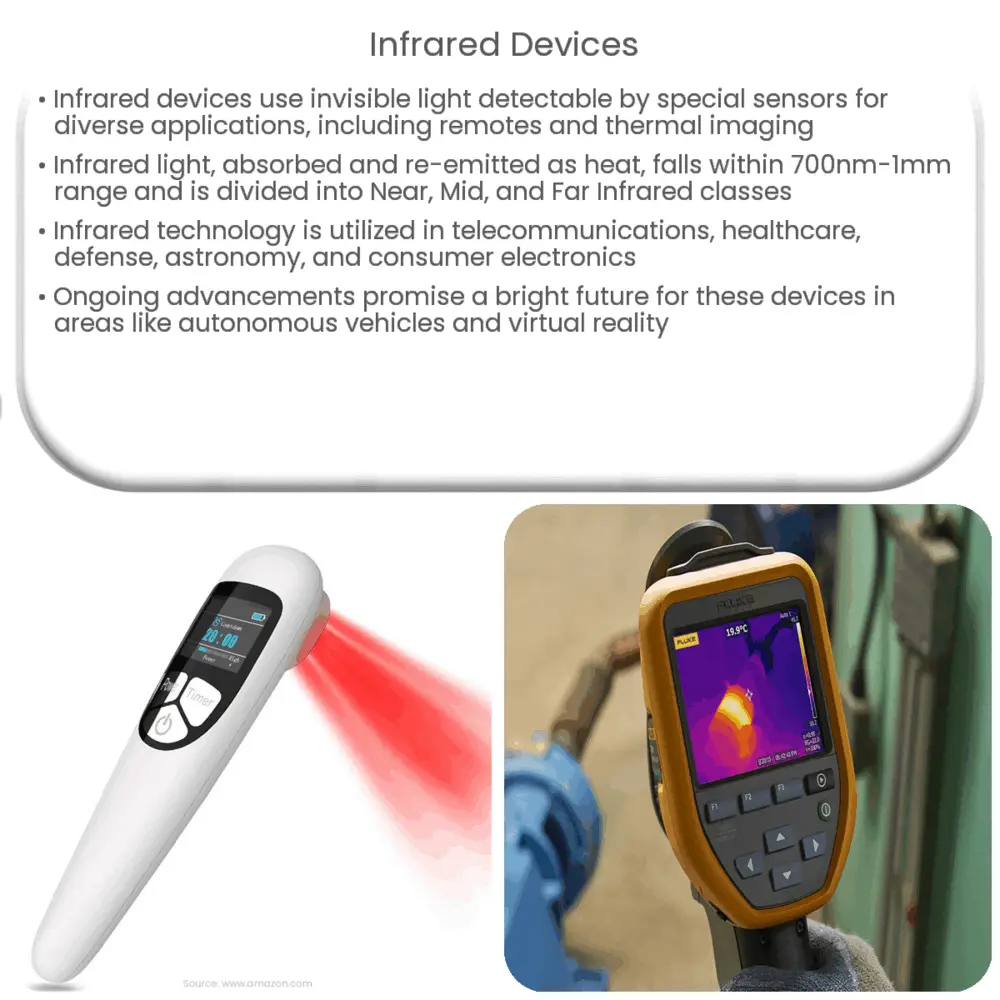Explore the world of infrared devices, their workings, applications in various fields, and their promising future in this comprehensive article.

Infrared Devices: An In-depth Overview
Infrared devices, simply put, are tools and technologies that leverage infrared light, a type of light that is invisible to the naked eye but detectable by special sensors. This radiation lies between microwaves and visible light in the electromagnetic spectrum.
The applications of infrared technology are widespread and incredibly diverse, ranging from everyday gadgets like television remote controls to advanced systems like thermal imaging cameras used in various sectors. This vast range of applications is attributed to the unique properties of infrared light, which we will delve into in the following sections.
Understanding Infrared Light
Infrared light is characterized by wavelengths longer than those of visible light, and shorter than those of terahertz radiation and microwaves. Falling within the 700 nanometer (nm) to 1 millimeter (mm) range, this radiation is generally invisible to human eyes. However, it can be detected as heat, given its property of being absorbed by objects and subsequently re-emitted as thermal radiation.
Classes of Infrared Light
When it comes to infrared radiation, it is usually categorized into three classes based on wavelength:
- Near Infrared (NIR): Ranging from 700 nm to 1400 nm
- Mid Infrared (MIR): Ranging from 1400 nm to 3000 nm
- Far Infrared (FIR): Above 3000 nm
Each class has its own specific applications and is used differently in various devices.
How Infrared Devices Work
Infrared devices function by either emitting or detecting infrared light. For instance, a remote control emits infrared light in specific patterns corresponding to different commands (volume up, channel change, etc.). An infrared sensor in the TV detects these signals and performs the commanded action.
Infrared cameras or thermal imagers, on the other hand, detect infrared radiation emitted by objects. They convert this radiation into an electrical signal that produces a thermal image, thereby visualizing temperature variations.
Other notable devices that utilize infrared technology include night vision equipment, spectroscopy devices, and even certain medical equipment. This highlights the vast applicability of this technology and underpins its relevance in our day-to-day lives.
Applications of Infrared Devices
Infrared devices find utility in a wide array of fields due to their diverse capabilities. Let’s delve into some of the key areas:
- Telecommunication: Fiber-optic communication systems often use infrared light (specifically NIR) due to its excellent data transmission capabilities.
- Healthcare: Infrared thermography is used for body temperature screening, while infrared therapy devices are used for treating various medical conditions.
- Military and Law Enforcement: Infrared sensors and cameras are used for surveillance, navigation, and targeting in low light conditions.
- Astronomy: Infrared telescopes help astronomers see through cosmic dust to observe celestial bodies otherwise hidden in the visual spectrum.
Infrared Devices in Consumer Electronics
Perhaps the most familiar use of infrared technology for many people is in consumer electronics. The vast majority of remote controls, for instance, use infrared LEDs to send signals to devices like TVs, sound systems, and air conditioners.
The Future of Infrared Devices
As technology continues to advance, we can expect further innovations and improvements in infrared devices. Infrared technology’s potential in areas such as autonomous vehicles, healthcare, and even virtual reality signifies that this field has a promising future ahead.
Conclusion
Infrared devices, though often unnoticed, play an integral role in our daily lives. By leveraging the unique properties of infrared light, these devices contribute significantly to various sectors, including telecommunications, healthcare, defense, astronomy, and consumer electronics. Their diverse applications and continuous technological advancements reaffirm their importance and promise an exciting future in an ever-increasing range of applications.


